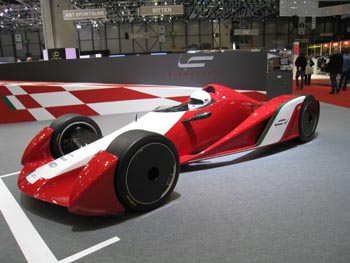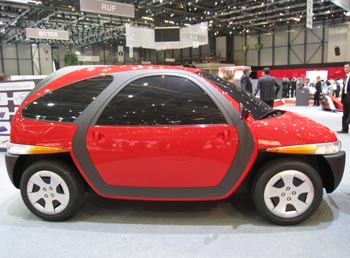
 |
|
Fioravanti has
turned up in Geneva with two design projects that its
believes are both, although from extreme ends of the
spectrum, are typically drawn from traditional Italian areas
of strength: a future F1 car study (top) that looks to lower costs
and a research overlap with road cars and a small, cheap to
build economical urban car (bottom). |
|
 |
|
|
|
Fioravanti has
turned up in Geneva with two design projects that its
believes are both, although from extreme ends of the
spectrum, are typically drawn from traditional Italian areas
of strength: a future F1 car study that looks to lower costs
and a research overlap with road cars and a small, cheap to
build economical urban car.
LF1
Fioravanti is a design company recognised for
its "out-of-the-box" thinking and thanks to this
characteristic combined with the strong passion of its
personnel in Geneva it is dealing with the topic of Formula 1.
"Since we think that in a period of heavy economic crisis,
in particular for the automotive world, also the Formula 1
has to be reviewed in its principle. Creating more
connection between F1
research the road cars production, making the races more
interesting with more overtaking manoeuvres still
maintaining the Grand Prix a the top of the media global
events," says Fioravanti in its Geneva Motor Show press
release. "LF1 wants only to be an auspice for a future Formula 1 regulation, based on
more general simplicity, with it Fioravanti shows one of the
possible solutions."
The vehicle has
been designed referring to the next 1800 cc. turbo engines
as recently proposed for the 2012 regulations. With this it has
been possible to define a very compact bodywork with less
aerodynamic drag and turbulences. Radiators and
intercoolers are designed with forced air using fans in
order to reduce the front wheel drag. 18-inch rims and tyres
with dimensions more similar to the road and racing GT cars,
allow the use of braking systems similar to the
ones utilised in the high performance road cars with advanced use of
the K.E.R.S., as in production cars, more eco-oriented for
fuel consumption savings.
Over
the years aerodynamics has became more and more relevant in Formula 1,
affecting performances, costs, racing and the aesthetics. The inspiring
principle of the project has been the reduction of the
aerodynamic drag and turbulence. This goal has been reached
taking advantage of the ground effect in an innovative
manner, removing the wings as not integrated bodywork
elements. The shape of the
central body is characterised from lift-down force ratio
close to zero. The front wing
is integrated in the front end and contributes at the same
time for the downforce and for the reduction of the front
wheel drag thanks to the side fairings. The rear wing,
with quite big dimensions, is integrated in the bottom of the
vehicle generating consistent down force. In order to give
an optimal ground effect and to keep the vehicle with a
constant distance from the ground Fioravanti proposes a return of
active suspensions use that is widely utilizsd in the
production cars.
The C.F.D.
(Computer Fluid Dynamic) study has confirmed that, with a
measurement done at 10 meters from the back of the car, the
degree of turbulence generated by the aerodynamic drag
is very low. Considering the above it could be possible to
suggest, at regulation level
the check of the drag energy and degree of turbulence in a
transversal section positioned 10 meters from the rear of
the car. This could allow
drivers to do more overtaking on all circuits giving
them the possibility to decide, more than today, when and
how to overtake, allowing battles between several cars and
driving tactics that emphasize the driver talent.
The LF1 is 4,200 mm
long, 950 mm high and 1,820 mm wide with a wheelbase of
2,800 mm. Magneti Marelli, Brembo, Pirelli, Ansys and Coggiola
were all involved in the project and the LF1, dressed in
traditional Italian red-white-and-green coluours in Geneva,
bears their decals.
Tris
In an environment where the low cost car will have a growing
part to play in every market, including the most developed,
Fioravanti again proposes the Tris project which it first
showed in 2000. The project to develop an economical car is typical of Italian design, Fioravanti
wants to define a low cost car with new parameters, not only
looking to production places where the labour costs are
lower, but designing a vehicle that is intrinsically
economical.
The purpose of
this vehicle, characterised by patented solutions, is to
influence a future series of cars on which components will be
strongly reduced in their number. Such components will no
longer identified with numbers and definitions in respect to
their positions, but they will be designed only for their
function. This is a new way to think and to approach the
basic vehicle. The doors will no longer be “right door n…”
and “left door n..” or “ rear door n…”, the bumper will no
longer be front bumper and rear bumper, the lighting will no
longer be the front left headlight and rear left headlight.
All these elements will be defined only as 'opening
function', 'bumper function', and 'lighting function'
because these components will be exactly the same component regardless of their position (left, right, front,
rear). Also the
protective framework structure is influenced by this new
approach; it is identical on both side of the vehicle,
making the appearance of Tris typical. The two rear
side-windows are identical too.
This design idea
spreads to the whole production chain, from the development phase
to simplifying feasibility, engineering and prototyping
before going on
the production itself benefiting the plant, tooling, assembly
and logistics. With the patented body solutions of Tris,
Fioravanti thinks is possible to
reach a true low cost car, equipped with future eco-friendly
engines or traditional ones, for which dimensions don’t need to
be necessarily reduced. Tris is 3,850 mm long, 1,720 mm
wide, 1,530 mm high and with a wheelbase of 2,550 mm.
|